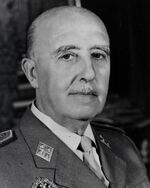Premier of the Federation of Ottonian Republics: Difference between revisions
m (Fanboy moved page Premier of Ottonia to Premier of the Federation of Ottonian Republics: Canon updates.) |
|
(No difference)
| |
Revision as of 14:17, 15 December 2023
| Premier of the Ottonian Federation | |
|---|---|
 Flag of the Ottonia | |
| Style | His Excellency (formal, international correspondence) |
| Residence | The Federal Hold, Federal District of Roan-Ottonia |
| Term length | 20 years, renewable |
| Inaugural holder | Rikard Filius September 21st, 1922 |
| Formation | Treaty of Ottonia, September 21st, 1872 |
| Salary | Ø100,000 annually |
The Premiership is the highest office in the Ottonian Federation, serving as the chief executive of the Federation, charged with enforcing and implementing the law as passed by the Federal Legislature, the Federal Assembly. Despite this nominal separation of power, the Ottonian premier has typically had significant de facto legislative power, using executive orders other measures to both make and enforce laws. This separation of power has only recently resumed being a reality, since the 1999 ascension of Andrik U'Daanyl.
The current Allamunnic head of state is Premier Andrik U'Daanyl.
Selection and Election
The highest executive office of the Ottonian Federation is, at least nominally, selected by the Council of Regents, an otherwise largely-ceremonial body made up of representatives of the state governments and former high officials. In practice, Premiers have often come to power riding support from the military, civil service, general public, or some combination thereof, with the Council essentially confirming an outside appointment.
There are very few statutory limitations on who can be named Premier, with the only written requirements specifying an Allamunnic citizen of at least 35 years of age of sound mind. By tradition, Premiers are typically selected from among the military, civil service, or elected government, with only a few exceptions. The Premier officially serves a term of 20 years, although they are considered to be eligible for re-selection at the end of their term, and functionally most premiers have left office either through resignation, removal from office, or death.
Duties & Powers
Officially, the Premier is the Federation's chief diplomat, commander-in-chief of the armed forces, and the head of government. They are charged with enforcing the law as written and passed by the Federal Assembly. They are permitted to declare states of emergency, mobilize national assets (military and civilian) in times of crisis, and mediate disputes between states.
Unofficially, the Premiership for most of the Federation's history has been autocratic in nature, issuing executive orders to make policy, using coercion (often via military force or security forces) to ensure confirmation by democratically-elected bodies and to keep the states in line. In a handful of cases, Premiers have voluntarily stayed within their official constitutional bounds, but these cases have been the exception rather than the norm.
To assist in their governing duties, the Premier is permitted to appoint a cabinet, as well as lower level federal officials including administrators of federal assets, federal judges, and high-ranking military officials. These appointments are nominally confirmed by the Federal Assembly, although traditionally said approval has been a foregone conclusion.
List of Premiers of Ottonia
Color key: Federalist Alliance National Front Popular Front
| No. | Portrait | Name (Born-Died) |
Term of office | Faction/Party |
|---|---|---|---|---|
| 0 | 
|
Skaadi U'Daanyl (1804 - 1895) |
(1852 - 1872) | Nationalist Coalition |
| Selected as Captain-General of the Pan-Ottonian Confederation in 1854. Led Nationalist forces through the War of Ottonian Unification (1858 - 1872). Oversaw the systematic destruction of organized resistance to Ottonian unification. Helped draft the Treaty of Ottonia. Resigned in 1872 as part of a compromise in the Treaty of Ottonia, creating the Ottonian Federation in exchange for her resignation and replacement by Rikard Filius. Length of time in office served as baseline for 20 year term of premiership. Unofficially considered to be the first Allamunnic head of state, despite never actually holding office during the Federation's existence. Sometimes referred to as "The Mother of the Federation". | ||||
| 1 | 
|
Rikard Filius (1821 - 1892) |
(1872 - 1892) | Federalist Alliance |
| First head of state of the Ottonian Federation, and a former leader of the Nationalist forces. Takes office as part of compromise with remaining anti-Nationalist forces to end fighting. Oversaw first national infrastructure and economic projects, including the First Ottonian Decade, a massive public spending program designed to rebuild war-ravaged parts of the country and connect the nation. Died of a heart attack aged 71, only two months before his term was set to expire. | ||||
| 2 | 
|
Moergyn Grahulm (1828 - 1908) |
(1892 - 1908) | Federalist Alliance |
| Trusted lieutenant to Filius, a former officer in the Nationalist forces, and de facto head of state to an ailing Filius early in 1892. Continued most of Filius' policies, while also enlarging the Federal Army and Federal Navy, as well as creating the Federal Guard as a national federal police and army reserve system. Implemented the first national health service and was noted for actively working against corporate consolidation and the formation of monopolies. Oversaw the design and completion of the first true Trans-Allamunnic rail line which ran uninterrupted from Vaalhulmspurt to Aldhuld. Designated first federal public lands. Died in 1908, aged 80, from a consumptive respiratory disease. | ||||
| 3 | 
|
Teresa Jaal (1860 - 1915) |
(1908 - 1915) | National Front |
| A popular member of the Federal Assembly with ties to numerous wealthy Allamunnae, Jaal was the beneficiary of vigorous lobbying and campaigning by corporate and private benefactors to succeed Moergyn Grahulm. Jaal was corrupt almost from the start, selling offices to the highest bidders and to loyalists, regardless of qualification. She significantly scaled back anti-trust measures and corporate taxes, and slashed budgets on public works and public assistance programs. Her use of federal troops to break strikes and protests further eroded her support among the military and civil service, and she failed to combat the alliance of the House of Sproek and the House of Kristhulm. It is unclear which of these factors lead to her assassination in 1915, at the age of 55, via cyanide poisoning, but regardless, the Royalist Revolt erupted within weeks of her death. | ||||
| 4 | 
|
Otto Kraag (1863 - 1930) |
(1915 - 1928) | Federalist Alliance |
| Otto Kraag was head of the Federal Army at the time of Jaal's death. Facing an armed insurrection by royalist supporters of self-styled Henrik I of Allamunnika, and his supporters among Sproek and Kristhulm loyalists, Kraag was confirmed Premier by the Council of Regents three weeks after Jaal's death. Kraag spent the first seven years of his regime organizing the suppression of the Royalist Revolt, ultimately ordering the campaigns that led to the extinction of the House of Kristhulm, the deaths of both pretenders to a proposed pan-Allamunnic monarchy, and the repulsion of an invasion of Onneria by Robert of Ghant, ending in the Ghantish prince's death. Following the end of the war, Kraag set about with an active rebuilding program, as well as carrying out administrative reforms to place tighter federal control over the activities of the Allamunnic state monarchies. Kraag became seriously ill in 1928, receiving a terminal lung cancer diagnosis that led to his resignation that same year in favor of a long-time supporter, one Junna Braandur. Kraag died out of office early in 1930 at the age of 67. | ||||
| 5 | 
|
Junna Braandur (1882 - 1934) |
(1928 - 1934) | Federalist Alliance |
| A long-time supporter and subordinate of Otto Kraag, Braandur was the Premier's choice to replace him following his resignation. As a life-long public servant and former military officer with significant support within the civil service, Braandur was confirmed relatively easily and went about continuing Kraag's rebuilding programs. Due to the damage wrought by the Royalist Revolt, Braandur forced herself to cut the Federal Armed Forces' budget, angering many former supporters and high-ranking officers. Those budget cuts, along with a tendency to micromanage high command decisions within the Federal Army are quite possibly what led to a 1934 coup which ousted her, led by Kaarlus Klaussunn. Eight days after the coup, Braandur died under suspicious circumstances at the age of 52, although the regime change ensured that the investigation into her death was perfunctory and reached no solid conclusion. | ||||
| 6 | 
|
Kaarlus Klaussunn (1875 - 1950) |
(1934 - 1949) | National Front |
| Klaussunn was the primary ringleader of the coup that ousted Junna Braandur from office, claiming she was a weak leader leading the country towards destruction. Klaussunn greatly expanded the military's budget and oversaw the expansion of the Federal Guard Service amid rising tensions with Ghant. In 1935, the forces of Nathan III of Ghant invaded the Federation's western coast. Klaussunn spent five of the first six years of his premiership overseeing the defense of Allamunnika and the repulsion of both invasions. Although the invasions were repulsed, hundreds of thousands of Allamunnic lives were lost and many of the Federation's most-economically-important cities were severely damaged. Klaussunn undertook a major rebuilding program, awarding sizable contracts to industrialists, Allamunnic corporations, and traditional nobility to undertake the reconstruction work on the government's behalf. He made liberal use of the Federal Guard to silence critics and enemies of his regime, fomenting civil unrest. While the economy began to recover and the cities rose from the rubble, these policies often did little to benefit the majority of the Allamunnic populace, who saw stagnant wages and persistently-terrible living conditions continuing with no real end in sight. This tension culminated in the General Strike of 1943, in which civil servants, students, and laborers walked out of their jobs en masse, bringing the country to a halt. Dissension within the Federal Army and Federal Guard came to a head when soldiers and guardsmen were ordered to use force to break the strike, resulting in armed confrontations between strikers, Klaussunn loyalists, and soldiers and guardsmen on both sides. The situation devolved into the civil war that would become the Great Allamunnic Revolution, with pro-labor forces coalescing under the leadership of Eleonur Hendrsunn, ousting Klaussunn from power in 1949 before trying and executing him for crimes against the Allamunnic people in 1950 at the age of 74. | ||||
| 7 | 
|
Eleonur Hendrsunn (1912 - 1981) |
(1949 - 1980) | Popular Front |
| Eleonur Hendrsunn rose to prominence as one of the civilian leaders of the pro-strike movement during the General Strike of 1943 and the ensuing Great Allamunnic Revolution, first serving as a firebrand and figurehead leader before becoming a key leading figure in the civilian government set up in areas liberated from the Klaussunn regime. In 1949 the revolutionaries succeeded in removing Klaussunn from power and forcing the surrender of the remainder of his government, and Hendrsunn was confirmed by the Council of Regents in February of 1949. Hendrsunn ordered the public trial of her predecessor, who was executed for his crimes against the Allamunnic people, as well as the trials of other high-ranking figures in the previous regime suspected of war crimes. However, Hendrsunn also notably issued large-scale pardons for soldiers and bureaucrats who had remained loyal to the previous regime, and she undertook another series of rebuilding projects, with efforts made to provide large scale general employment and to spread economic growth among the general populace. Hendrsunn shrunk the Federal Guard while expanding the welfare state and government service programs, all while becoming the first leader since Moergyn Grahulm to make an effort to include the Federal Assembly in directing legislation and new projects. Widespread employment and the success of the rebuilding programs resulted in an era of national prosperity for the Federation. Hendrsunn also oversaw a detente with Ghant, and helped to begin laying the groundwork for the Northern Ajax Treaty Association. Hendrsunn remained broadly popular, and saw her term extended in 1969 amid widespread popular and governmental support. Ultimately, she was forced to retire from governing in 1980 amidst failing health, and she died peacefully in 1981 at the age of 69. | ||||
| 8 | 
|
Theodur Junnsunn (1912 - 1986) |
(1980 - 1986) | Popular Front |
| A former military supporter of the Great Allamunnic Revolution and a staunch ally of Eleonur Hendrsunn, Theodur Junnsunn was recommended as Hendrsunn's successor at the time of her retirement and was easily confirmed by the Council of Regents. Although he generally opted to continue Hendrsunn's policies, the slowing of economic growth frustrated him and he found governing to be far more difficult than military administration. Increasingly, Junnsunn found himself relying on a charismatic young member of the Assembly who found his way into a cabinet appointment. By 1985, Junnsunn himself was in poor health, and it was an open secret that that Delegate-turned-Cabinet-member, one Eddard Jaal, was expected to succeed him. Junnsunn died in July of 1986 at the age of 74, and Jaal was easily confirmed his successor. | ||||
| 9 | 
|
Eddard Jaal (1945 - 2001) |
(1991 - 1999) | National Front |
| Jaal, a great nephew of Premier Teresa Jaal, became Premier with the death of Theodur Junnsunn. Jaal had already made himself a name based on charismatic speeches, as well as railing against the threat of communism to the east (specifically in Liothidia) and so-called sympathizers at home (generally painting ardent Labor supporters as such), calling for a move to a more pro-business government to renew economic growth that was now solidly in retreat. Although his supporters greeted these calls with enthusiasm, there was substantial pushback among the civil service and lower and working classes against his demonization of unions and public government services, and it became clear that much of his support was drawn from wealthy financiers, industrialists, executives, and the traditional landed nobility. This pushback prompted Jaal to re-expand the Federal Guard for use as a state security service to silence opponents of his regime, while also prompting the beginnings of a descent into paranoia. Starting in 1991, Jaal's personal mannerisms and subjects of his speeches became increasingly erratic, and many officials began to privately question his mental competence. This decline only worsened over the next five years, and by 1996 his paranoia was justified, as leaders in the military and civil service were actively plotting to remove him from power. These plots came to a head in 1999, when several elements of the Allamunnic Federal Defense Service launched a coup that removed Jaal from power. This sudden removal triggered a civil war between more moderate elements and more radical communist forces backed by neighboring Rietumimark, which would last until 2002. Jaal himself was tried for crimes against the Allamunnic people and was executed in 2001 at the age of 56. | ||||
| 10 | 
|
Andrik U'Daanyl (1943 - ) |
(2000 - 2020) | Federalist Alliance |
| Andrik U'Daanyl was ultimately selected by the leaders of the coup from among themselves to lead the Federation first through the civil war that followed Eddard Jaal's removal from power, then to establish a new, more technocratic government that could reform the Federation's government and restore the people's faith in the system. U'Daanyl was chosen in large part due to his nature as a consensus-builder who had generally avoided self-aggrandizement, along with his pedigree (as a descendant of Captain-General Skaadi U'Daanyl and his lengthy career of public service. U'Daanyl has over the course of his regime been relatively hands-off, focusing on finding capable subordinates to administer the various areas of Allamunnic public life and service. To that end, he has been mostly successful, overseeing a renewal of the Allamunnic welfare state, public works projects, and extensive anti-corruption efforts meant to combat the endemic corruption that took root during the Jaal regime. U'Daanyl has also been careful to leave substantial authority to the Federal Assembly and local governments (specifically at the prefectural level) while attempting to circumvent the monarchist state governments in many cases. U'Daanyl is the current Premier of the Federation as of 2018. | ||||